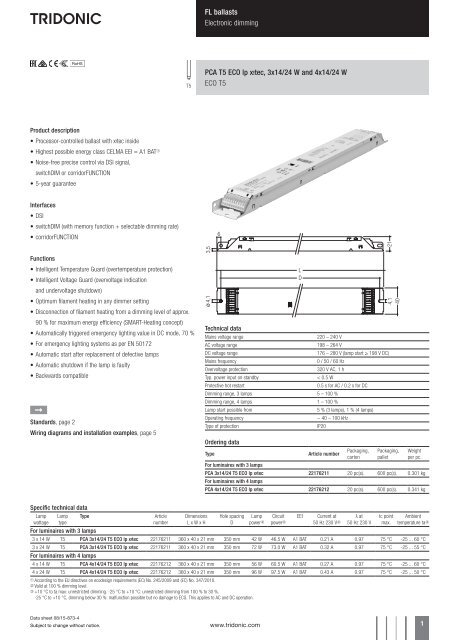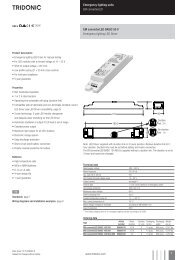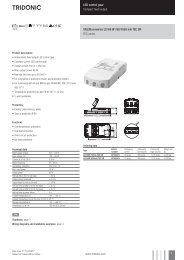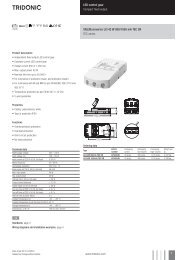PCA T5 ECO lp xitec, 3 and 4x14/24 W - Tridonic
PCA T5 ECO lp xitec, 3 and 4x14/24 W - Tridonic
PCA T5 ECO lp xitec, 3 and 4x14/24 W - Tridonic
You also want an ePaper? Increase the reach of your titles
YUMPU automatically turns print PDFs into web optimized ePapers that Google loves.
FL ballasts<br />
Electronic dimming<br />
<strong>T5</strong><br />
<strong>PCA</strong> <strong>T5</strong> <strong>ECO</strong> <strong>lp</strong> Y, 3x14/<strong>24</strong> W <strong>and</strong> <strong>4x14</strong>/<strong>24</strong> W<br />
<strong>ECO</strong> <strong>T5</strong><br />
Product description<br />
• Processor-controlled ballast with y inside<br />
• Highest possible energy class CELMA EEI = A1 BAT 1<br />
• Noise-free precise control via DSI signal,<br />
switchDIM or corridorFUNCTION<br />
• 5-year guarantee<br />
Interfaces<br />
• DSI<br />
• switchDIM (with memory function + selectable dimming rate)<br />
• corridorFUNCTION<br />
Functions<br />
• Intelligent Temperature Guard (overtemperature protection)<br />
• Intelligent Voltage Guard (overvoltage indication<br />
<strong>and</strong> undervoltage shutdown)<br />
• Optimum filament heating in any dimmer setting<br />
• Disconnection of filament heating from a dimming level of approx.<br />
90 % for maximum energy efficiency (SMART-Heating concept)<br />
• Automatically triggered emergency lighting value in DC mode, 70 %<br />
• For emergency lighting systems as per EN 50172<br />
• Automatic start after replacement of defective lamps<br />
• Automatic shutdown if the lamp is faulty<br />
• Backwards compatible<br />
È<br />
St<strong>and</strong>ards, page 2<br />
Wiring diagrams <strong>and</strong> installation examples, page 5<br />
3,5<br />
4,1<br />
6<br />
Technical data<br />
Mains voltage range<br />
220 – <strong>24</strong>0 V<br />
AC voltage range<br />
198 – 264 V<br />
DC voltage range<br />
176 – 280 V (lamp start ≥ 198 V DC)<br />
Mains frequency<br />
0 / 50 / 60 Hz<br />
Overvoltage protection<br />
320 V AC, 1 h<br />
Typ. power input on st<strong>and</strong>by<br />
< 0.5 W<br />
Protective hot restart<br />
0.5 s for AC / 0.2 s for DC<br />
Dimming range, 3 lamps 5 – 100 %<br />
Dimming range, 4 lamps 1 – 100 %<br />
Lamp start possible from<br />
5 % (3 lamps), 1 % (4 lamps)<br />
Operating frequency<br />
~ 40 – 100 kHz<br />
Type of protection<br />
IP20<br />
Ordering data<br />
Type<br />
L<br />
D<br />
Article number<br />
Packaging,<br />
carton<br />
21<br />
4,1<br />
40<br />
Packaging,<br />
pallet<br />
Weight<br />
per pc.<br />
For luminaires with 3 lamps<br />
<strong>PCA</strong> 3x14/<strong>24</strong> <strong>T5</strong> <strong>ECO</strong> <strong>lp</strong> Y 22176211 20 pc(s). 600 pc(s). 0.301 kg<br />
For luminaires with 4 lamps<br />
<strong>PCA</strong> <strong>4x14</strong>/<strong>24</strong> <strong>T5</strong> <strong>ECO</strong> <strong>lp</strong> Y 22176212 20 pc(s). 600 pc(s). 0.341 kg<br />
Specific technical data<br />
Lamp<br />
wattage<br />
Lamp<br />
type<br />
Type<br />
For luminaires with 3 lamps<br />
Article<br />
number<br />
Dimensions<br />
L x W x H<br />
Hole spacing<br />
D<br />
Lamp<br />
power2<br />
Circuit<br />
power2<br />
EEI<br />
Current at<br />
50 Hz 230 V2<br />
λ at<br />
50 Hz 230 V<br />
tc point<br />
max.<br />
Ambient<br />
temperature ta3<br />
3 x 14 W <strong>T5</strong> <strong>PCA</strong> 3x14/<strong>24</strong> <strong>T5</strong> <strong>ECO</strong> <strong>lp</strong> Y 22176211 360 x 40 x 21 mm 350 mm 42 W 46.5 W A1 BAT 0.21 A 0.97 75 °C -25 ... 60 °C<br />
3 x <strong>24</strong> W <strong>T5</strong> <strong>PCA</strong> 3x14/<strong>24</strong> <strong>T5</strong> <strong>ECO</strong> <strong>lp</strong> Y 22176211 360 x 40 x 21 mm 350 mm 72 W 73.0 W A1 BAT 0.32 A 0.97 75 °C -25 ... 55 °C<br />
For luminaires with 4 lamps<br />
4 x 14 W <strong>T5</strong> <strong>PCA</strong> <strong>4x14</strong>/<strong>24</strong> <strong>T5</strong> <strong>ECO</strong> <strong>lp</strong> Y 22176212 360 x 40 x 21 mm 350 mm 56 W 60.5 W A1 BAT 0.27 A 0.97 75 °C -25 ... 60 °C<br />
4 x <strong>24</strong> W <strong>T5</strong> <strong>PCA</strong> <strong>4x14</strong>/<strong>24</strong> <strong>T5</strong> <strong>ECO</strong> <strong>lp</strong> Y 22176212 360 x 40 x 21 mm 350 mm 96 W 97.5 W A1 BAT 0.43 A 0.97 75 °C -25 ... 50 °C<br />
1 According to the EU directives on ecodesign requirements (EC) No. <strong>24</strong>5/2009 <strong>and</strong> (EC) No. 347/2010.<br />
2 Valid at 100 % dimming level.<br />
3 +10 °C to ta max: unrestricted dimming. -25 °C to +10 °C: unrestricted dimming from 100 % to 30 %.<br />
-25 °C to +10 °C, dimming below 30 %: malfunction possible but no damage to ECG. This applies to AC <strong>and</strong> DC operation.<br />
Data sheet 08/15-873-4<br />
Subject to change without notice.<br />
www.tridonic.com 1
FL ballasts<br />
Electronic dimming<br />
St<strong>and</strong>ards<br />
EN 55015<br />
EN 55022<br />
EN 60929<br />
EN 61000-3-2<br />
EN 61347-2-3<br />
EN 61547<br />
Suitable for emergency installations according to<br />
EN 50172<br />
Mains currents in DC operation (at 70 % light output)<br />
Wattage Mains current at<br />
Mains current at<br />
Type<br />
Un = 220 VDC<br />
Un = <strong>24</strong>0 VDC<br />
<strong>PCA</strong> 3x14/<strong>24</strong> <strong>T5</strong> <strong>ECO</strong> <strong>lp</strong> X 3x14 W 0.17 A 0.16 A<br />
<strong>PCA</strong> 3x14/<strong>24</strong> <strong>T5</strong> <strong>ECO</strong> <strong>lp</strong> X 3x<strong>24</strong> W 0.28 A 0.26 A<br />
<strong>PCA</strong> <strong>4x14</strong>/<strong>24</strong> <strong>T5</strong> <strong>ECO</strong> <strong>lp</strong> X <strong>4x14</strong> W 0.22 A 0.21 A<br />
<strong>PCA</strong> <strong>4x14</strong>/<strong>24</strong> <strong>T5</strong> <strong>ECO</strong> <strong>lp</strong> X 4x<strong>24</strong> W 0.37 A 0.34 A<br />
Lamp starting characteristics<br />
Warm start<br />
Starting time 0.5 s with AC<br />
Starting time 0.2 s with DC<br />
Start at any dimming level<br />
AC operation<br />
Mains voltage<br />
220–<strong>24</strong>0 V 50/60 Hz<br />
198–264 V 50/60 Hz including safety<br />
tolerance (±10 %)<br />
202–254 V 50/60 Hz including performance<br />
tolerance (+6 % / -8 %)<br />
Ballast lumen factor AC operation (AC-BLF) EN 60929 8.1<br />
Wattage<br />
AC-BLF at<br />
Type<br />
U = 230 VAC<br />
<strong>PCA</strong> 3x14/<strong>24</strong> <strong>T5</strong> <strong>ECO</strong> <strong>lp</strong> X 3x14 W 0.99<br />
<strong>PCA</strong> 3x14/<strong>24</strong> <strong>T5</strong> <strong>ECO</strong> <strong>lp</strong> X 3x<strong>24</strong> W 0.99<br />
<strong>PCA</strong> <strong>4x14</strong>/<strong>24</strong> <strong>T5</strong> <strong>ECO</strong> <strong>lp</strong> X <strong>4x14</strong> W 0.99<br />
<strong>PCA</strong> <strong>4x14</strong>/<strong>24</strong> <strong>T5</strong> <strong>ECO</strong> <strong>lp</strong> X 4x<strong>24</strong> W 0.99<br />
The ballast lumen factor for AC operation (AC-BLF) does not alter from Un = 198 V AC to Un = 254 V AC.<br />
The ballast lumen factor for DC operation (DC-BLF) on the basis of an automatic power reduction of the ballasts<br />
(default value is 70 %) will be smaller than AC. It does not alter in the DC operating range (198–280 V DC).<br />
DC operation<br />
220–<strong>24</strong>0 V 0 Hz<br />
198–280 V 0 Hz certain lamp start<br />
176–280 V 0 Hz operating range<br />
Use in emergency lighting installations according to<br />
EN 50172 or for emergency luminaires according<br />
to EN 61347-2-3 appendix J.<br />
Harmonic distortion in the mains supply (at 230 V / 50 Hz)<br />
Type Wattage THD 3 5 7 9 11<br />
<strong>PCA</strong> 3x14/<strong>24</strong> <strong>T5</strong> <strong>ECO</strong> <strong>lp</strong> X 3x14 W 8.40 6.65 1.97 2.17 2.09 1.36<br />
<strong>PCA</strong> 3x14/<strong>24</strong> <strong>T5</strong> <strong>ECO</strong> <strong>lp</strong> X 3x<strong>24</strong> W 7.98 6.23 1.76 1.75 2.31 1.04<br />
<strong>PCA</strong> <strong>4x14</strong>/<strong>24</strong> <strong>T5</strong> <strong>ECO</strong> <strong>lp</strong> X <strong>4x14</strong> W 8.67 6.97 2.85 1.86 1.49 1.19<br />
<strong>PCA</strong> <strong>4x14</strong>/<strong>24</strong> <strong>T5</strong> <strong>ECO</strong> <strong>lp</strong> X 4x<strong>24</strong> W 7.52 6.37 1.53 1.94 1.04 1.08<br />
Emergency units<br />
The “<strong>PCA</strong> <strong>T5</strong> <strong>ECO</strong> <strong>lp</strong> x” ballasts are compatible<br />
with all emergency units from <strong>Tridonic</strong>. See the table in<br />
the data sheet. Also all “5-pole” emergency units can<br />
be used. When used with other emergency units tests<br />
are necessary.<br />
Temperature range<br />
Unlimited dimming range from 10 °C to ta max.<br />
-25 °C to +10 °C: dimming operation from 100 %<br />
to 30 %. If dimm level goes below 30 % malfunction<br />
possible, but no electronic ballast damage.<br />
This applies to AC <strong>and</strong> DC operation.<br />
Lamp type recognition<br />
Each of teh lamps for wich the control gear is designed<br />
will be operated correctly according the lamp<br />
specification. The currently used lamp is recognised<br />
during the start up process.<br />
To avoid an incorrect lamp recognition due to fast<br />
multiple ON / OFF switches, new lamp data are only<br />
restored if the lamp has operated for at least 5<br />
seconds.<br />
Data sheet 08/15-873-4<br />
Subject to change without notice.<br />
www.tridonic.com 2
FL ballasts<br />
Electronic dimming<br />
Dimming<br />
Dimming curve is adapted to the eye sensitiveness.<br />
Dimming range:<br />
4-lamp: 1 % to 100 %, 3-lamp: 5 % to 100 %<br />
Digital control with:<br />
• DSI signal: 8 bit Manchester Code<br />
Speed 1 % to 100 % in 1.4 s<br />
Control input (D1, D2)<br />
A push-to-make switch (switchDIM) can be wired on<br />
the same terminals (D1 <strong>and</strong> D2).<br />
Digital signal DSI<br />
The control input is non-polar <strong>and</strong> protected against<br />
accidental connection with a mains voltage up to<br />
264 V. The control signal is not SELV. Control cable has<br />
to be installed in accordance to the requirements of<br />
low voltage installations.<br />
Different functions depending on each module.<br />
SMART interface<br />
An additional interface for the direct connection of<br />
the SMART-LS II <strong>lp</strong> 1) light sensor. The sensor registers<br />
actual ambient light <strong>and</strong> maintains the individually<br />
defined lux level.<br />
After every mains reset the SMART interface automatically<br />
checks for an installed sensor. With the<br />
sensor installed the <strong>PCA</strong> <strong>T5</strong> <strong>ECO</strong> one4all <strong>lp</strong> x<br />
automatically runs in the constant lux level mode.<br />
ON/OFF switch via mains, switchDIM or DSI signal.<br />
DSI signal = 0 switches off,<br />
DSI signal ≥ 1 switches on.<br />
With switchDIM signals it is possible to change the<br />
controlled light level temporarily. Temporarily means<br />
that after a switching cycle OFF/ON comm<strong>and</strong> the<br />
ballast will start at the preset value determined by the<br />
SMART-LS II <strong>lp</strong>. The installation of the two wire bus is<br />
according to the appropriate low voltage regulations.<br />
switchDIM<br />
Integrated switchDIM function allows a direct<br />
connection of a push to make switch for dimming<br />
<strong>and</strong> switching.<br />
Brief push (< 0.6 s) switches ballast ON <strong>and</strong> OFF. The<br />
ballasts switch-ON at light level set at switch-OFF.<br />
When the push to make switch is held, <strong>PCA</strong> ballasts<br />
are dimmed. After repush the <strong>PCA</strong> is dimmed in the<br />
opposite direction.<br />
1)<br />
SMART-LS II <strong>lp</strong>: article number 86458258<br />
Dimming characteristics<br />
<strong>PCA</strong> <strong>T5</strong> <strong>ECO</strong> <strong>lp</strong><br />
digital dimming value<br />
255<br />
225<br />
200<br />
175<br />
DSI<br />
150<br />
125<br />
100<br />
75<br />
50<br />
25<br />
0<br />
0 10 20 30 40 50 60 70 80 90 100<br />
relative lighting level in %<br />
Dimming characteristics as seen by the human eye<br />
The switchDIM fade time is set to 3 s from min. to<br />
max. in the factory settings. With a 20 s push to the<br />
push to make switch this fade time can be changed<br />
to 6 s. In this instance the switchDIM application will<br />
be synchronized to 50 % light level after 10 s <strong>and</strong> after<br />
20 s the light level rises to 100 % with the new fade<br />
time.<br />
At every synchronizsation (10 s keystroke) the device<br />
will reset to 3 s (factory setting)<br />
In installations with <strong>PCA</strong>s with different dimming levels<br />
or opposite dimming directions (e.g. after a system<br />
extension), all <strong>PCA</strong>s can be synchronized to 50 %<br />
dimming level by a 10 s push.<br />
Use of push to make switch with indicator lamp is not<br />
permitted.<br />
Deactivation: If the corridorFUNCTION is wrongly<br />
activated in a switchDIM system (for example a<br />
switch is used instead of pushbutton), there is the<br />
option of installing a pushbutton <strong>and</strong> deactivating the<br />
corridorFUNCTION mode by five short pushes of the<br />
button within three seconds.<br />
switchDIM <strong>and</strong> corridorFUNCTION are very simple tools<br />
for controlling ballastswith conventional momentaryaction<br />
switches or motion sensors.<br />
To ensure correct operation a sinusoidal mains voltage<br />
with a frequency of 50 Hz or 60 Hz is required at the<br />
control input.<br />
Special attention must be paid to achieving clear zero<br />
crossings.<br />
Serious mains faults may impair the operation of<br />
switchDIM <strong>and</strong> corridorFUNCTION.<br />
Energy saving<br />
<strong>PCA</strong> <strong>T5</strong> <strong>ECO</strong> <strong>lp</strong><br />
mains power in %<br />
100<br />
90<br />
80<br />
70<br />
60<br />
50<br />
40<br />
30<br />
20<br />
10<br />
0<br />
100 90 80 70 60 50 40 30 20 15 10 5 4 3 2 1<br />
dimming level in %<br />
Backwards compatibility<br />
With a simple key combination a <strong>PCA</strong> <strong>T5</strong> <strong>ECO</strong> <strong>lp</strong> y<br />
can be reset as a normal <strong>PCA</strong> <strong>ECO</strong> from the previous<br />
generation. Synchronisation simply has to take place<br />
three times within one minute (3 x 10 s).<br />
To activate the “y” settings again, synchronisation<br />
has to take place four times within one minute.<br />
switchDIM <strong>PCA</strong> <strong>T5</strong> <strong>ECO</strong> <strong>lp</strong> Y<br />
DSI<br />
N<br />
L<br />
DSI <strong>PCA</strong> <strong>T5</strong> <strong>ECO</strong> <strong>lp</strong> Y<br />
2<br />
3<br />
4<br />
5 D1<br />
6 D2<br />
2<br />
3<br />
4<br />
5<br />
6<br />
D1<br />
D2<br />
Dimmable ballasts from <strong>Tridonic</strong> have to be earthed.<br />
Loading of automatic circuit breakers<br />
Automatic circuit breaker type C10 C13 C16 C20 B10 B13 B16 B20<br />
Installation Ø 1.5 mm 2 1.5 mm 2 1.5 mm 2 2.5 mm 2 1.5 mm 2 1.5 mm 2 1.5 mm 2 2.5 mm 2<br />
<strong>PCA</strong> 3x14/<strong>24</strong> <strong>T5</strong> <strong>ECO</strong> <strong>lp</strong> Y 16 22 32 36 8 11 16 18<br />
<strong>PCA</strong> <strong>4x14</strong>/<strong>24</strong> <strong>T5</strong> <strong>ECO</strong> <strong>lp</strong> Y 14 22 32 34 7 11 16 17<br />
Continuous operation: to calculate the protective saftey switch see main current, page 1<br />
Data sheet 08/15-873-4<br />
Subject to change without notice.<br />
www.tridonic.com 3
FL ballasts<br />
Electronic dimming<br />
corridorFUNCTION<br />
Activation: To activate the corridorFUNCTION a voltage<br />
of 230 V simply has to be applied for five minutes at<br />
D1, D2. The unit will then switch automatically to the<br />
corridorFUNCTION.<br />
Deactivation: If the corridorFUNCTION is wrongly<br />
activated in a switchDIM system (for example a<br />
switch is used instead of pushbutton), there is the<br />
option of installing a pushbutton <strong>and</strong> deactivating the<br />
corridorFUNCTION mode by five short pushes of the<br />
button within three seconds.<br />
The corridorFUNCTION V2 offers the added benefit of a<br />
second <strong>and</strong> third preprogrammed profile.<br />
With the usage of the corridorFUNCTION plugs to activate<br />
the different profiles, the corridorFUNCTION will<br />
be activated automatically. Application <strong>and</strong> functionallity<br />
of profiles see user manual corridorFUNCTION.<br />
Intelligent Temperature Guard<br />
The intelligent temperature guard protects the<br />
<strong>PCA</strong> <strong>T5</strong> <strong>ECO</strong> <strong>lp</strong> x from temporary thermal overheating<br />
by reducing the output power or switching<br />
off in case of operation above the thermal limits of<br />
the luminaire or ballast. Depending on the luminaire<br />
design, the ITG operates at about 5 to 10 °C above Tc<br />
temperature.<br />
Intelligent Voltage Guard<br />
Intelligent Voltage Guard is the name of the new electronic<br />
monitor from <strong>Tridonic</strong>. This inno vative feature of<br />
the <strong>PCA</strong> family of control gear from<br />
<strong>Tridonic</strong> immediately shows if the mains voltage rises<br />
above certain thresholds. Measures can then be taken<br />
quickly to prevent damage to the control gear.<br />
• If the mains voltage rises above approx. 305 V<br />
(voltage depends on the ballast type), the lamp<br />
starts flashing on <strong>and</strong> off.<br />
• This signal “dem<strong>and</strong>s” disconnection of the<br />
power supply to the lighting system.<br />
• The active-current-control of these control gears<br />
is protected against failure caused by the high mains<br />
currents generated as a result of mains undervoltage.<br />
The switch off level depends on lamp wattage<br />
<strong>and</strong> is typically < 140 V.<br />
Operating voltage<br />
Installation instructions<br />
Wiring type <strong>and</strong> cross section<br />
The wiring can be solid cable with a cross section of<br />
0.5 to 0.75 mm² for push terminal <strong>and</strong> 0.5 mm² for<br />
IDC terminal. For the push-wire connection you have<br />
to strip the insulation (8–9 mm).<br />
wire preparation:<br />
0.5 – 0.75 mm²<br />
8 – 9 mm<br />
Type Wattage Uout<br />
<strong>PCA</strong> 3x14/<strong>24</strong> <strong>T5</strong> <strong>ECO</strong> <strong>lp</strong> X 3x14 W 430 V<br />
<strong>PCA</strong> 3x14/<strong>24</strong> <strong>T5</strong> <strong>ECO</strong> <strong>lp</strong> X 3x<strong>24</strong> W 430 V<br />
<strong>PCA</strong> <strong>4x14</strong>/<strong>24</strong> <strong>T5</strong> <strong>ECO</strong> <strong>lp</strong> X <strong>4x14</strong> W 430 V<br />
<strong>PCA</strong> <strong>4x14</strong>/<strong>24</strong> <strong>T5</strong> <strong>ECO</strong> <strong>lp</strong> X 4x<strong>24</strong> W 430 V<br />
Wiring advice<br />
The lead length is dependent on the capacitance of the cable.<br />
Ballast Terminal Maximum capacitance allowed<br />
Type Cold Middle Hot Cold Middle Hot<br />
<strong>PCA</strong> 3x14/<strong>24</strong> <strong>T5</strong> <strong>ECO</strong> <strong>lp</strong> X 7, 8 9, 10, 14, 12, 13 100 pF 50 pF 100 pF<br />
15, 16, 17<br />
<strong>PCA</strong> <strong>4x14</strong>/<strong>24</strong> <strong>T5</strong> <strong>ECO</strong> <strong>lp</strong> X 14, 15, 16, 17 7, 8, 9, 10 12, 13, 18, 19 200 pF 50 pF 100 pF<br />
Loosen wire through<br />
twisting <strong>and</strong> pulling<br />
With st<strong>and</strong>ard solid wire 0.5 / 0.75 mm² the capacitance of the lead is 30 – 80 pF/m.<br />
This value is influenced by the way the wiring is made.<br />
Lamp connection should be made with symmetrical wiring.<br />
3-lamp devices: Hot <strong>and</strong> cold leads should be separated as much as possible.<br />
4-lamp devices: Middle <strong>and</strong> hot leads should be separated as much as possible.<br />
Hot leads (9, 10, 15, 16) <strong>and</strong> cold leads (11, 12, 13, 14) should be separated as much as possible.<br />
When using two or more dimmable ballasts in one luminaire with separate dimming controls, the lamp leads must<br />
be kept separate.<br />
Distance to plate: 5 – 10 mm<br />
(ideal distance for optimal symmetrical light)<br />
Data sheet 08/15-873-4<br />
Subject to change without notice.<br />
www.tridonic.com 4
FL ballasts<br />
Electronic dimming<br />
control<br />
signal<br />
2<br />
3<br />
4<br />
5 D1<br />
6 D2<br />
7<br />
8<br />
9<br />
10<br />
17<br />
16<br />
15<br />
14<br />
13<br />
12<br />
control<br />
signal<br />
2<br />
3<br />
4<br />
5 D1<br />
6 D2<br />
7<br />
8<br />
9<br />
10<br />
19<br />
18<br />
17<br />
16<br />
15<br />
14<br />
13<br />
12<br />
* leads 12, 13: keep wires short, max. 1.0 m<br />
** leads 9, 10, 14, 15, 16, 17: keep wires short, max. 0.5 m<br />
leads 7, 8: max. 2.0 m<br />
<strong>PCA</strong> <strong>T5</strong> <strong>ECO</strong> one4all <strong>lp</strong> X 3x14/<strong>24</strong> W<br />
* leads 12, 13, 18, 19: keep wires short, max. 1.0 m<br />
** leads 7, 8, 9, 10: keep wires short, max. 0.5 m<br />
leads 14, 15, 16, 17: max. 2.0 m<br />
<strong>PCA</strong> <strong>T5</strong> <strong>ECO</strong> one4all <strong>lp</strong> X <strong>4x14</strong>/<strong>24</strong> W<br />
Dimmable ballasts from <strong>Tridonic</strong> have to be earthed.<br />
RFI<br />
• Connection to the lamps of the hot leads must<br />
be kept as short as possible<br />
• Mains leads should be kept apart from lamp leads<br />
(ideally 5–10 cm distance)<br />
• Do not run mains leads adjacent to the<br />
electronic ballast<br />
• Twist the lamp leads<br />
• Keep the distance of lamp leads from the<br />
metal work as large as possible<br />
• Mains wiring to be twisted when through wiring<br />
• Keep the mains leads inside the luminaire as short<br />
as possible<br />
General advise:<br />
Electronic ballasts are virtually noise free.<br />
Magnetic fields generated during the ignition cycle<br />
can cause some background noise but only for a<br />
few milliseconds.<br />
Operation on DC voltage<br />
Our ballasts are construed to operate DC voltage <strong>and</strong><br />
pulsed DC voltage.<br />
To operate ballasts with pulsed DC voltage the polarity<br />
is absolute m<strong>and</strong>atory.<br />
2<br />
3<br />
4<br />
5<br />
6<br />
–<br />
+<br />
D1<br />
D2<br />
Isolation <strong>and</strong> electric strength testing of<br />
luminaires<br />
Electronic devices can be damaged by high voltage.<br />
This has to be considered during the routine testing of<br />
the luminaires in production.<br />
According to IEC 60598-1 Annex Q (informative only!)<br />
or ENEC 303-Annex A, each luminaire should be submitted<br />
to an isolation test with 500 V DC for 1 second.<br />
This test voltage should be connected between the<br />
interconnected phase <strong>and</strong> neutral terminals <strong>and</strong> the<br />
earth terminal.<br />
The isolation resistance must be at least 2 MΩ.<br />
As an alternative, IEC 60598-1 Annex Q describes a<br />
test of the electrical strength with 1500 V AC (or 1.414<br />
x 1500 V DC). To avoid damage to the electronic devices<br />
this test must not be conducted.<br />
For further technical information please visit www.tridonic.com<br />
Data sheet 08/15-873-4<br />
Subject to change without notice.<br />
www.tridonic.com 5










